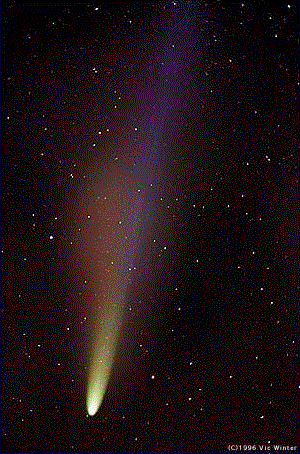Credit & Copyright: Vic
Winter, Courtesy
ICSTARS
Explanation:
What makes comet tails so colorful?
This
photograph of Comet Hyakutake was
taken the night of April 18th and highlights different
components of the tail. The gold
and red tail features are
dust, made predominately of little bits of rock
and carbon. The dust tail shines by reflecting sunlight. Extending past
the dust tail is the comet's ion tail,
shown here glowing in blue. The ion tail is composed mostly of ions of
water, carbon monoxide, and
cyanogen.
The ion tail glows by emitting light
when elections re-combine with electrically charged ions to make uncharged
molecules. The photograph was taken just north of Kansas City, Missouri,
USA.
Latest Comet Hyakutake images:
APOD Hyakutake Archive,
JPL,
Fayetteville
Observer-Times,
NASA's Night of
the Comet,
ICSTARS,
Jerry Lodriguss,
ScienceWeb,
Crni Vrh Obs.,
1999 2000 2001 2002 2003 2004 2005 2006 2007 2008 2009 2010 2011 2012 2013 2014 2015 2016 2017 2018 2019 2020 2021 2022 2023 2024 2025 |
Yanvar' Fevral' Mart Aprel' Mai Iyun' Iyul' Avgust Sentyabr' Oktyabr' Noyabr' Dekabr' |
NASA Web Site Statements, Warnings, and Disclaimers
NASA Official: Jay Norris. Specific rights apply.
A service of: LHEA at NASA / GSFC
& Michigan Tech. U.
|
Publikacii s klyuchevymi slovami:
comet Hyakutake - kometa Hiyakutake - kometnye hvosty - rekombinaciya
Publikacii so slovami: comet Hyakutake - kometa Hiyakutake - kometnye hvosty - rekombinaciya | |
Sm. takzhe:
Vse publikacii na tu zhe temu >> | |
